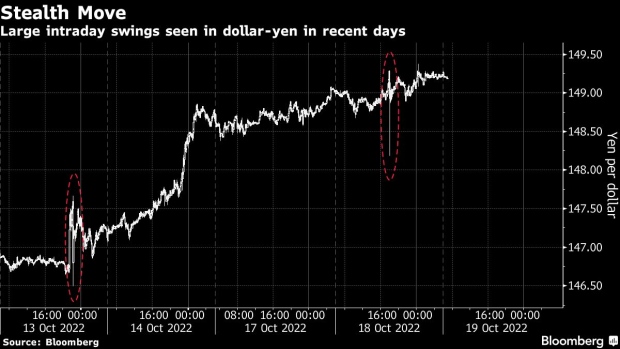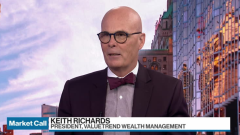Oct 18, 2022
Stealth Intervention Talk Permeates Market as Yen Approaches 150
, Bloomberg News

(Bloomberg) -- The yen carried on its seemingly inevitable decline toward 150 per dollar, as traders scoured intraday moves for evidence of subtle intervention from Japan.
Twice in under a week investors have seen sudden bursts of yen strength as it edged to fresh lows, spurring speculation that officials were subtly intervening to support the currency. The yen traded around the 149.30 level Wednesday, after weakening to 149.38 on Tuesday in a volatile session which included such a spike.
“The move seems to have been driven off of electronic flows rather than ‘voice’ driven flows which points to ‘stealth’ intervention,” Brad Bechtel, global head of FX at Jefferies LLC, wrote in a note. “Maybe they are warming up to defend 150.00 as the next big psychological level.”
Market watchers expect Japan to focus on the pace of the yen’s decline rather than any particular number. But 150 is seen as an important psychological level in Japan and a break may increase pressure on authorities for further action.
The yen has tumbled about 23% against the greenback this year thanks to a yawning monetary policy differential between the US and Japan. The currency has wiped out last month’s intervention-driven gains despite the government confirming an almost $20 billion spend and unleashing a barrage of further warnings to dissuade traders from testing its resolve.
“The intervention effects seem to be declining steadily,” said Masafumi Yamamoto, chief currency strategist at Mizuho Securities in Tokyo. “The chance has become higher that the dollar-yen will exceed 150.”
Ready for Action
Finance Minister Shunichi Suzuki warned Wednesday that Japan was intensifying its monitoring of markets and remained ready to take action if needed.
“We’re increasing the frequency of our detailed checks on market moves,” Suzuki said to reporters. “We maintain our existing thinking on how to respond to markets.”
Speaking in parliament, BOJ Governor Haruhiko Kuroda repeated his view that a weak yen is good for the economy overall if it softens in a stable manner, but said recent abrupt and one-sided moves were not.
“This sort of yen move makes it difficult for businesses to plan ahead, increases future uncertainty, and is negative for the economy,” Kuroda said. “It’s undesirable.”
Bond Vigilantes Revive Wagers on a BOJ Hawkish Policy Shift
Top currency official Masato Kanda said last month that stealth intervention was among the possible options for the government and it wouldn’t necessarily confirm when it takes place. Such a move typically involves entering the market on a smaller scale that is more difficult to detect instead of the sharp sudden large shifts associated with more regular intervention.
By one estimate, authorities may have spent around 1 trillion yen ($6.7 billion) to support the currency in a stealth move on Thursday. A Ministry of Finance official declined to comment on that move.
“The estimated probability of intervention is high currently as the upward momentum in dollar-yen has rebuilt,” Adam Cole, chief currency strategist at RBC Capital Markets, wrote in a note. “Our forecast peak of 150 for dollar-yen is starting to look conservative already.”
(Updates with comment from Mizuho.)
©2022 Bloomberg L.P.






